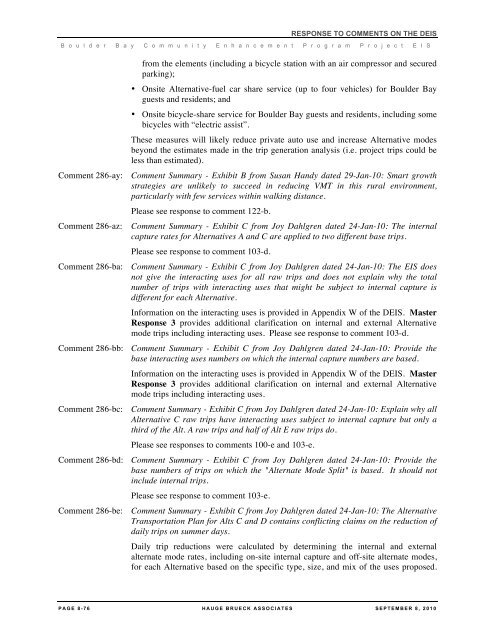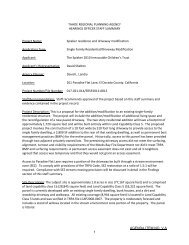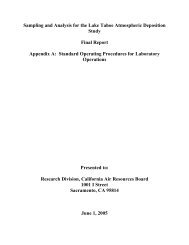FEIS - Tahoe Regional Planning Agency
FEIS - Tahoe Regional Planning Agency
FEIS - Tahoe Regional Planning Agency
You also want an ePaper? Increase the reach of your titles
YUMPU automatically turns print PDFs into web optimized ePapers that Google loves.
RESPONSE TO COMMENTS ON THE DEIS<br />
B o u l d e r B a y C o m m u n i t y E n h a n c e m e n t P r o g r a m P r o j e c t E I S<br />
from the elements (including a bicycle station with an air compressor and secured<br />
parking);<br />
• Onsite Alternative-fuel car share service (up to four vehicles) for Boulder Bay<br />
guests and residents; and<br />
• Onsite bicycle-share service for Boulder Bay guests and residents, including some<br />
bicycles with “electric assist”.<br />
These measures will likely reduce private auto use and increase Alternative modes<br />
beyond the estimates made in the trip generation analysis (i.e. project trips could be<br />
less than estimated).<br />
Comment 286-ay: Comment Summary - Exhibit B from Susan Handy dated 29-Jan-10: Smart growth<br />
strategies are unlikely to succeed in reducing VMT in this rural environment,<br />
particularly with few services within walking distance.<br />
Please see response to comment 122-b.<br />
Comment 286-az: Comment Summary - Exhibit C from Joy Dahlgren dated 24-Jan-10: The internal<br />
capture rates for Alternatives A and C are applied to two different base trips.<br />
Please see response to comment 103-d.<br />
Comment 286-ba: Comment Summary - Exhibit C from Joy Dahlgren dated 24-Jan-10: The EIS does<br />
not give the interacting uses for all raw trips and does not explain why the total<br />
number of trips with interacting uses that might be subject to internal capture is<br />
different for each Alternative.<br />
Information on the interacting uses is provided in Appendix W of the DEIS. Master<br />
Response 3 provides additional clarification on internal and external Alternative<br />
mode trips including interacting uses. Please see response to comment 103-d.<br />
Comment 286-bb: Comment Summary - Exhibit C from Joy Dahlgren dated 24-Jan-10: Provide the<br />
base interacting uses numbers on which the internal capture numbers are based.<br />
Information on the interacting uses is provided in Appendix W of the DEIS. Master<br />
Response 3 provides additional clarification on internal and external Alternative<br />
mode trips including interacting uses.<br />
Comment 286-bc: Comment Summary - Exhibit C from Joy Dahlgren dated 24-Jan-10: Explain why all<br />
Alternative C raw trips have interacting uses subject to internal capture but only a<br />
third of the Alt. A raw trips and half of Alt E raw trips do.<br />
Please see responses to comments 100-e and 103-e.<br />
Comment 286-bd: Comment Summary - Exhibit C from Joy Dahlgren dated 24-Jan-10: Provide the<br />
base numbers of trips on which the "Alternate Mode Split" is based. It should not<br />
include internal trips.<br />
Please see response to comment 103-e.<br />
Comment 286-be: Comment Summary - Exhibit C from Joy Dahlgren dated 24-Jan-10: The Alternative<br />
Transportation Plan for Alts C and D contains conflicting claims on the reduction of<br />
daily trips on summer days.<br />
Daily trip reductions were calculated by determining the internal and external<br />
alternate mode rates, including on-site internal capture and off-site alternate modes,<br />
for each Alternative based on the specific type, size, and mix of the uses proposed.<br />
PAGE 8- 76 HAUGE BRUECK ASSOCIATES SEPTEMBER 8 , 2010






